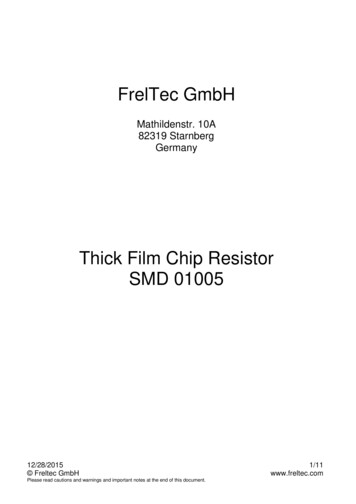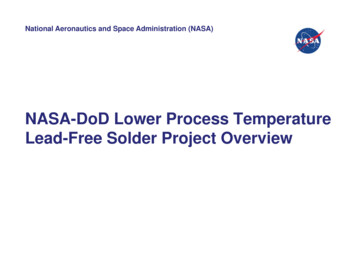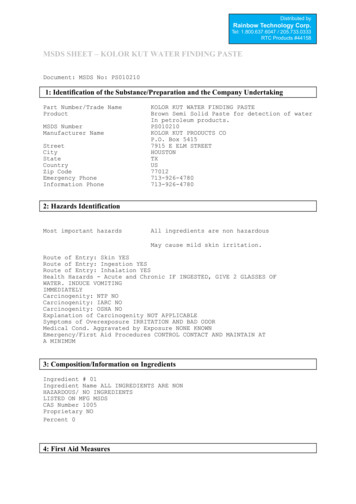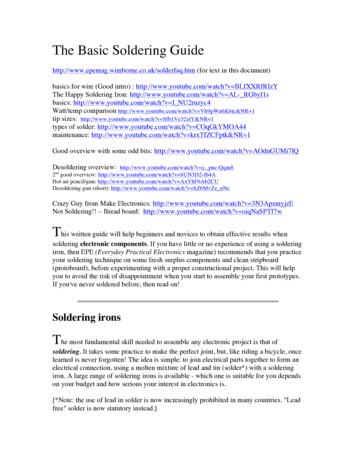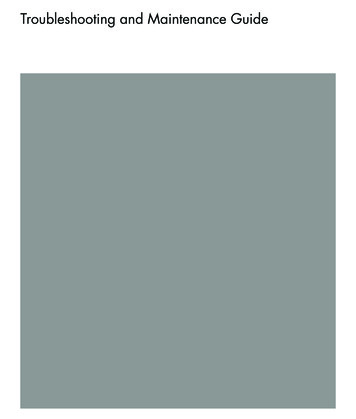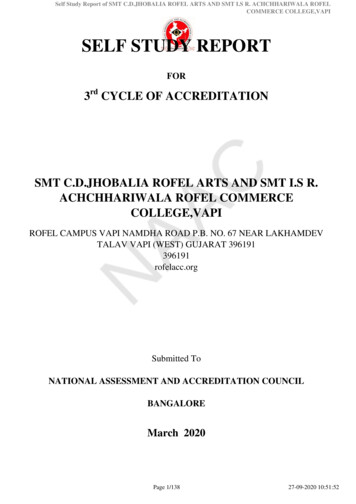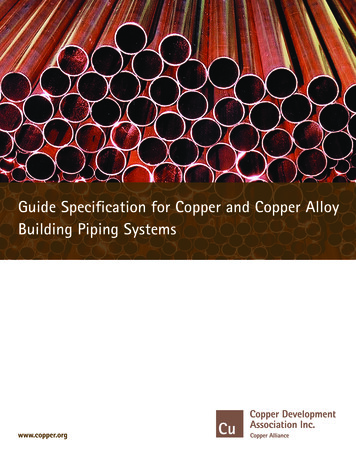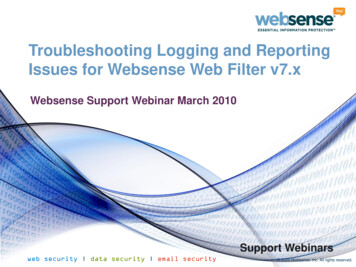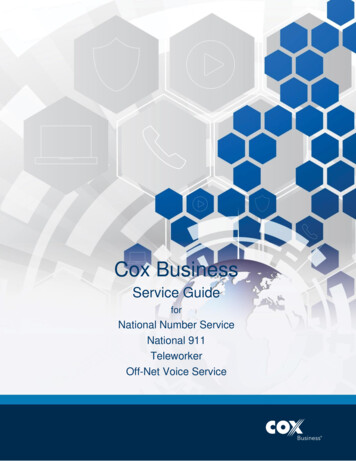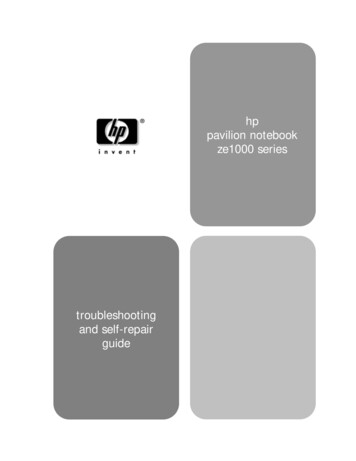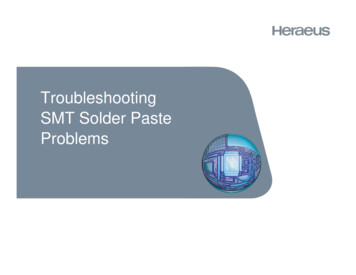
Transcription
TroubleshootingSMT Solder PasteProblems
Printing BasicsPrint speed and Squeegee pressure are inter-related Factors effecting speed Temperature Cold slow as pastes are very temperature sensitive Squeegee Material Polymer is faster than metal Poly is simply a better squeegee (windshield wipers) Poly wears very quickly, not common today Sharpness Not all metal squeegees are equal Plating of Transition Automation is round and dull Angle 60 degree is faster than 45 degree Watch out for MPM; long blades low angles with high pressuresW.C. Heraeus SMT Applications Training SeminarModule 3: Solder Paste TroubleshootingPage 2
Various Metal Squeegee Blades0.01700.0075Stock DEK0.00950.0100E-BladeW.C. Heraeus SMT Applications Training Seminar0.0120Print-PerfectDuraGlideModule 3: Solder Paste TroubleshootingUltraprintPage 3
Various Metal Blade CharacteristicsStock DEKAMTX(PhotoStencil)TransitionAutomationPhoto StencilAlpha MetalsMaterialSpring StainlessNickelSpring SteelSpring SteelSpring neNone“Permalex”Teflon/nickelTitanium NitrideNickel plateBody Thickness7.5 mils10 mils9.5 mils12 mils17 milsTip Thickness (bottom0.1”)7.5 mils10 mils10 mils11.5 mils17 milsRelative Sharpness**68474Forming MethodCoatingW.C. Heraeus SMT Applications Training SeminarModule 3: Solder Paste TroubleshootingPage 4
F365 Print Speed Benchmarks With Various Squeegees45 Degree SqueegeeStock DEKE-BladePrintPerfectDuraGlideUltraprintMaximum speed at 3lb/in2.00 IPS1.25 IPS1.50 IPS3.75 IPS1.60 IPSMaximum speed at 2lb/in1.25 IPS1.00 IPS1.25 IPS1.75 IPS1.00 IPSMinimum pressure at 6IPSN/ON/ON/O5.5 lb/inN/O60 Degree SqueegeeStock DEKE-BladePrintPerfectDuraGlideUltraprintMaximum speed at 3lb/in4.25 IPS3.75 IPS3.25 IPS6.00 IPS2.75 IPSMaximum speed at 2lb/in3.25 IPS3.25 IPS1.30 IPS4.25 IPS1.80 IPSMinimum pressure at 6IPSN/ON/ON/O2.7 lb/in4.3 lb/inW.C. Heraeus SMT Applications Training SeminarModule 3: Solder Paste TroubleshootingPage 5
Printing Basics (continued) Stencil Roughness Rougher better for roll Rougher requires more pressure for clean wipe Etched or lasered foil is more rougher than EFAB Paste factors Higher viscosity usually equates to slower print speed and higher pressure. Higher tackiness usually equates to slower print speed and higher pressure. Squeegee pressure take away message “Apply minimum pressure to get a clean wipe, (no solder powder) around the apertures” This is independent of all of the other variables effecting squeegee pressureW.C. Heraeus SMT Applications Training SeminarModule 3: Solder Paste TroubleshootingPage 6
W.C. Heraeus SMT Applications Training SeminarModule 3: Solder Paste TroubleshootingPage 7
Printing Basics (continued)Stencil Issues Not all stencils release equally well EFAB is best Laser is OK, with electro polish or nickel plate is better Chemical etch is worst Stencil wiping not totally effective Automated better than manual Coined solder can remain and cause more needed wipingW.C. Heraeus SMT Applications Training SeminarModule 3: Solder Paste TroubleshootingPage 8
Coined solder on bottom of stencilW.C. Heraeus SMT Applications Training SeminarModule 3: Solder Paste TroubleshootingPage 9
Printing Basics (continued)Sticking to squeegee Paste viscosity too high Solids too high Paste got hot in storage or shipment Insufficient paste on the stencil Start with 15gr/cm of squeegee length Squeegee lift incorrect Too high after stroke 0.5” to 0.75” is OK Too slow Fast ( 10mm/s) helps shear paste and leave on stencil Pause between prints too long Paste rheology goes back to rest viscosity Short stroke AOI too slowW.C. Heraeus SMT Applications Training SeminarModule 3: Solder Paste TroubleshootingPage 10
Printing Basics (continued)Gasketing is critical for good paste release Aperture must be smaller than pad in both length and width Critical for fine pitch, small componentsHeight (mils) Legend near fine pitch is NGBar code or other labels near fine pitch is NGMask should be pad height except over tracesHASL can be a hassle2.0Solder Mask Wall1.6Solder Pad1.20.8510152025303540Width (mils)W.C. Heraeus SMT Applications Training SeminarModule 3: Solder Paste TroubleshootingPage 11
Single Pad HASL Anomaly5.04.54.03.53.02.52.01.51.0Height (mils)W.C. Heraeus SMT Applications Training SeminarModule 3: Solder Paste TroubleshootingPage 12
Fine Pitch Solder Pad82C593 Pin 181MaskPadCross SectionPad2.82.7Mask2.62.52.4Silk Legend2.32.22.12.0All Dimensions in Mils1.91.8W.C. Heraeus SMT Applications Training SeminarModule 3: Solder Paste TroubleshootingPage 13
Printing Basics (continued)Compaction (happens only with solder paste) ProFlow is DEK Compaction in corners and upper head Rheopump is MPM Compaction is in center (print area) Compaction is “pressured separation” Flux squeezed out, solids rise, flow inhibited Remedies Thixatrope level Solids Powder source Cannot be fixed in the process! Temporary solution Clean out head and replace with fresh material Show ProFlow HeadW.C. Heraeus SMT Applications Training SeminarModule 3: Solder Paste TroubleshootingPage 14
Reflow BasicsGeneric Profileo245 C Peak250o219 C20045 SecLiquidus150Preheat Range100o1 - 2 C/ sec.500060120180240300SecondsW.C. Heraeus SMT Applications Training SeminarModule 3: Solder Paste TroubleshootingPage 15
Reflow Basics (continued)Profiling Fast response thermocouples (thin gauge)Tip must be welded not twisted to be accurateThermocouple, connectors and lead wires must all be the same type (J,K)Type “K” most common, “J” also worksTip must be fixed to surface to be measured Aluminum tape or high temp solder are best Too much Kapton tape (yellow) can “tent” thermocouple and give lower reading Not fixed to surface can give too hot a reading Best is high temp solder to component leads For BGA, bury the thermocouple tip into a center ball (coldest) Basic needs for Applications Support Peak temp Time above liquidus (TAL) Time from entrance to peak Shape of preheatW.C. Heraeus SMT Applications Training SeminarModule 3: Solder Paste TroubleshootingPage 16
Reflow Basics (continued)Preheat Shape Soak or Ramp? Soak is less preferred but necessary with certain applications Very thick board (back panels, etc.) Laminated metal backing or heat spreader Assemblies in any type of tray, fixture or jig Excessive soak time ( 60s) or temp ( 150C) can weaken paste activationCustomers Profile “Cold” looking solder jointsW.C. Heraeus SMT Applications Training SeminarModule 3: Solder Paste TroubleshootingPage 17
Reflow Basics (continued) Ramp is preferred preheat shape in ALL applications where possible and ALL formulationsSoakW.C. Heraeus SMT Applications Training SeminarRampModule 3: Solder Paste TroubleshootingPage 18
Reflow Basics (continued)N2 versus O2 reflow Environment N2 Benefits Wetting Lead free components Lead free alloys Old components Oxidized surface finishes (Sn) Flux appearance More residue spread, appears like less residue Lighter color Better cleaning (for water cleans) Less solder balls Helps OSP survive more reflow excursionsW.C. Heraeus SMT Applications Training SeminarModule 3: Solder Paste TroubleshootingPage 19
Reflow Basics (continued) N2 Disadvantages Cost Not all ovens or facilities are capable Some defects are aggravated Tombstones Solder beads Flux mobility Flux will move farther from solder joint due to lower surface tension Can get down a via to the backside of the assembly Can contaminate wire bond finger or connection pad surfaceW.C. Heraeus SMT Applications Training SeminarModule 3: Solder Paste TroubleshootingPage 20
Reflow Basics (continued)Wetting Issues Component solderability Lead free components in a Sn63 process Extend liquidus time, peak temp or both MUST test shows slow wetting time but strong wetting forces Extend liquidus time, peak temp or both MUST test shows slow wetting time and weak wetting forces Add solder volume Replace with stronger activation paste Use nitrogen reflow Have customer seek replacement from component supplier or distributor Component Coplanarity Add solder height Add placement depth Replace with stronger activation paste Use nitrogen reflowW.C. Heraeus SMT Applications Training SeminarModule 3: Solder Paste TroubleshootingPage 21
QFP Coplanarity ExampleW.C. Heraeus SMT Applications Training SeminarModule 3: Solder Paste TroubleshootingPage 22
Foot-in-mud, Ball-in-socket, Head-in-pillow defect formation theoryAt placement, a component with some ( 0) coplanarity is placed on top of the solderdeposit. The high lead, in these defects, is not touching the solder paste or barely touching the solderpaste. During the preheat portion of the reflow profile the solder paste goes from a firm pasteconsistency to a hard deposit. There is a slight shrinkage due to the loss of solvents and othervolatiles but the printed pads of solder paste hold their shape rigidly. So at this point in the reflowprocess there is still an air gap between the bottom of the lead and the top of the solder paste. If therewas just barely contact at placement then there most likely is now an air gap going into the reflowportion of the profile. Without a physical bond of the lead foot bottom surface and the top of thesolder paste there is no or an inadequate thermal link between the surfaces to be soldered (lead,solder & PCB pad). This thermal link is a basic requirement for the formation of a solder joint thatincludes the lead of the component. Very shortly into the reflow portion the solder paste depositunder the bent lead, without the thermal burden of the lead, will reach liquidus and collapse abruptlysoldering only to the pad. Shortly after that event the rest of the leads will reflow and the componentwill collapse towards the board at a rate which is directly proportional to its solderability. Verysolderable parts combined with pads designs wide enough to accommodate the generation of sidefillets will collapse more vigorously. At the moment of this collapse the bent or high lead which wasoriginally deprived of flux at placement and through pre-heat will push into the molten solder beneathit and solidify unsoldered as the reflow process ends. These leads may actually have a layer of fluxresidue under them but this brief thermal link came too late in the reflow process to initiate thesoldering process to the lead foot.From a solder paste standpoint the firmer the deposit the worse, this can be aggravatedby higher solids that also presents less wetness to the solder deposit which is critical to form thatearly thermal bond that is critical. Increased placement depth and reduced component coplanarityare the most powerful elements for elimination of this defect type. With most of the lead finishesmoving to lead free (Sn) these days, solderability will be compromised. A higher peak temp and/or alonger liquidus ( 90s) can help solderability with pure tin plated leads.W.C. Heraeus SMT Applications Training SeminarModule 3: Solder Paste TroubleshootingPage 23
Reflow Basics (continued) Gold Plating too thick Bulk solder looks “cold” Solder joints have massive voiding Solder joint is extremely brittle 3-5% gold in bulk solderW.C. Heraeus SMT Applications Training SeminarModule 3: Solder Paste TroubleshootingPage 24
Reflow Basics (continued)W.C. Heraeus SMT Applications Training SeminarModule 3: Solder Paste TroubleshootingPage 25
Reflow Basics (continued)Gold: 0.5µ - 1.0µGold: 3.0µCustomer Spec: 0.4µ - 0.9µW.C. Heraeus SMT Applications Training SeminarModule 3: Solder Paste TroubleshootingPage 26
Reflow Basics (continued)Surface finish effects ENIG is simply best Wetting Voiding Defects IPC-4552 covers this finish specifications Electroless Nickel: 120 -240µin (3-6 microns) Immersion Gold: 3-5µin (0.075-0.125 microns) Immersion silver is second best If thickness is too thick, Champaign voiding is inevitable OSP and Immersion tin are third OSP limited reflow excursions Concern of shelf life and variability with Immersion tinW.C. Heraeus SMT Applications Training SeminarModule 3: Solder Paste TroubleshootingPage 27
Reflow Basics (continued)WettingWettingEntek (Cu)Ni/Au140020120012281232400 ppm200 ppm11491227123350 ppm25 06906004003.620000Air800 ppm400 ppm200 ppm100 ppm50 ppm25 ppmAir800 ppmReflow AtmosphereWetting DWetting CWetting B100 ppmReflow AtmosphereWetting AWetting DWetting CWetting BWettingWettingSnAg20201515Wetting 0.5100 ppm50 ppm1053.512.511.84.50Air800 ppm400 ppm200 ppm100 ppm50 ppm25 ppmAir800 ppmReflow AtmosphereWetting DWetting CWetting BW.C. Heraeus SMT Applications Training Seminar400 ppm200 ppm25 ppmReflow AtmosphereWetting AWetting DWetting CModule 3: Solder Paste TroubleshootingWetting BWetting APage 28
Reflow Basics (continued)CuSnW.C. Heraeus SMT Applications Training SeminarAuDewetModule 3: Solder Paste TroubleshootingAgPage 29
Reflow Basics (continued)CuAuSnAgW.C. Heraeus SMT Applications Training SeminarModule 3: Solder Paste TroubleshootingPage 30
Solder DefectsSolder DefectsEntek (Cu)Ni/Au300300250250200Solder DefectsSolder DefectsReflow Basics 114106107115800 ppm400 ppm200 ppm100 ppm505000Air800 ppm400 ppm200 ppm100 ppm50 ppmAir25 ppmTombstonesSolder BeadsTombstonesSolder BallsSolder BeadsSolder DefectsSolder DefectsSnAg30025 ppmSolder Balls300253248221250226215202200Solder DefectsSolder Defects50 ppmReflow AtmosphereReflow 0126100825000Air800 ppm400 ppm200 ppm100 ppm50 ppm25 ppmAir800 ppm400 ppmReflow AtmosphereTombstonesSolder Beads200 ppm100 ppm50 ppm25 ppmReflow AtmosphereSolder BallsW.C. Heraeus SMT Applications Training SeminarTombstonesSolder BeadsModule 3: Solder Paste TroubleshootingSolder BallsPage 31
Reflow Basics (continued)X-Ray VoidingX-Ray VoidingEntek (Cu)Ni/Au10041314-116-6-9 -13-14-34-50607559708839240-100Air800 ppm400 ppm200 ppm100 ppm50 ppmAir25 ppm800 ppm400 ppmReflow AtmosphereX-Ray Points Preforms200 ppm100 ppm50 ppm25 ppmReflow AtmosphereX-Ray Points BGAX-Ray Points PreformsX-Ray Points BGAX-Ray VoidingX-Ray 8-26-29-41-36-250-13-50-46 -43-100800 ppm400 ppm200 ppm100 ppm50 ppmReflow AtmosphereX-Ray Points Preforms-14-26-100Air154X-Ray Points BGAW.C. Heraeus SMT Applications Training Seminar25 ppm-29-42-94Air-52-90-96800 ppm400 ppm-98-98-97-94200 ppm100 ppm50 ppm25 ppmReflow AtmosphereX-Ray Points PreformsModule 3: Solder Paste TroubleshootingX-Ray Points BGAPage 32
Reflow Basics (continued)Immersion TinW.C. Heraeus SMT Applications Training SeminarImmersion GoldModule 3: Solder Paste TroubleshootingPage 33
Reflow Basics (continued)No PreformCopper PreformImmersion SilverW.C. Heraeus SMT Applications Training SeminarImmersion GoldModule 3: Solder Paste TroubleshootingPage 34
Reflow Basics (continued)Old Board LotW.C. Heraeus SMT Applications Training SeminarNew Board LotModule 3: Solder Paste TroubleshootingPage 35
Reflow Basics (continued)Common Reflow Defects Solder Beads Higher solids paste can help Paste with low or no hot slump can help Air reflow (if nitrogen) can help Home plate aperture design (effective) Crown aperture design (most effective)W.C. Heraeus SMT Applications Training SeminarModule 3: Solder Paste TroubleshootingPage 36
Reflow Basics (continued)X-Rays after placement but before reflow10% Inside ReductionW.C. Heraeus SMT Applications Training SeminarHome PlateModule 3: Solder Paste TroubleshootingCrownPage 37
Reflow Basics (continued)Preferred SolutionW.C. Heraeus SMT Applications Training SeminarModule 3: Solder Paste TroubleshootingPage 38
Reflow Basics (continued) Solder Balls Nitrogen reflow can minimize Poor miss-print board cleaning? Look for solder balls in the vias Water clean Pre cleaning process solder balls are normal Poor stencil to pad gasketing? Profile not optimal Ramp-to-spike preferredW.C. Heraeus SMT Applications Training SeminarModule 3: Solder Paste TroubleshootingPage 39
Reflow Basics (continued) Tombstones Paste not registered pads properly Component not centered on pads Inter-pad gap too big (common in European designs) Shrink gap One pad tied to thermal drain such as a via Variable component end term solderability Air reflow (assumes nitrogen reflow) Anti-tombstone alloy Blurs reflow event to help form both solder joints together Post reflow alloy is the sameW.C. Heraeus SMT Applications Training SeminarModule 3: Solder Paste TroubleshootingPage 40
W.C. Heraeus SMT Applications Training SeminarModule 3: Solder Paste TroubleshootingPage 41
Reflow Basics (continued) Voiding Voiding is mainly due to expanding gas during reflow (liquidus) Water vapor Solvents Gaseous reaction byproducts Main source is paste formulation Generally more active formulations more voiding Generally Sn63 is better than Lead Free alloys Secondary source is surface finish ENIG is best, OSP is worst Tertiary source is component type BGA's give central large void Leadless and SOT devices have large parallel surfaces to trap voids Last (and least powerful) is profile Ramp is better than soak in preheatW.C. Heraeus SMT Applications Training SeminarModule 3: Solder Paste TroubleshootingPage 42
W.C. Heraeus SMT Applications Training SeminarModule 3: Solder Paste TroubleshootingPage 43
Cleaning BasicsMost no cleans are “Not Cleans”Water Clean basics Water should be de-ionized (DI) Water should be heated (120-160F) Impinging spray is best Gets under components Adds mechanical cleaning energy Drying is last step in cleaning process Certain high surface area dark solder masks will retain “flux stains” Cosmetic and very difficult to remove Nitrogen reflow helps Cleaning right after reflow helps Lowering peak reflow temp helps Clean after every reflow !W.C. Heraeus SMT Applications Training SeminarModule 3: Solder Paste TroubleshootingPage 44
Cleaning Basics (continued)Case Study: SiP Module “White Ring”W.C. Heraeus SMT Applications Training SeminarModule 3: Solder Paste TroubleshootingPage 45
W.C. Heraeus SMT Applications Training SeminarModule 3: Solder Paste TroubleshootingPage 46
W.C. Heraeus SMT Applications Training SeminarModule 3: Solder Paste TroubleshootingPage 47
W.C. Heraeus SMT Applications Training SeminarModule 3: Solder Paste TroubleshootingPage 48
W.C. Heraeus SMT Applications Training SeminarModule 3: Solder Paste TroubleshootingPage 49
Cleaning Basics (continued) SiP reflow/clean experiment conclusions White ring visible with both light microscope and electron microscope White ring is tin oxide Nitrogen minimizes ring All test coupons pass ion chromatography Blank boards failed for calcium ion White ring is cosmeticW.C. Heraeus SMT Applications Training SeminarModule 3: Solder Paste TroubleshootingPage 50
Lead Free BasicsCommon issues Printing is equal to or better than tin/lead Hot slump is typically more than tin/lead Wetting can be less than tin/lead Nitrogen reflow is helpful Surface finish of board very powerful Voiding can be more than tin/leadW.C. Heraeus SMT Applications Training SeminarModule 3: Solder Paste TroubleshootingPage 51
Lead Free Basics (continued) RoHS Challenges “We cannot defend our position as RoHS compliant from a customers solder joint” Amount of material is too small for a quantitative assay Solder in solder joint is a blend of board finish, paste and component finish Ownership of the assembly process is the customers. “Last word” testing is an ICP assay of bulk metal Requires 5-10grams reflowed in clean crucible Hand held XRF is useful and accurate for paste samples Borderline readings must be refereed by ICP SEM EDS is only qualitativeW.C. Heraeus SMT Applications Training SeminarModule 3: Solder Paste TroubleshootingPage 52
Stock DEK E-Blade Print-Perfect DuraGlide Ultraprint Maximum speed at 3lb/in 4.25 IPS 3.75 IPS 3.25 IPS 6.00 IPS 2.75 IPS Maximum speed at 2lb/in 3.25 IPS 3.25 IPS 1.30 IPS 4.25 IPS 1.80 IPS Minimum pressure at 6IPS N/O N/O N/O 2.7 lb/in 4.3 lb/in Stock DEK E-
